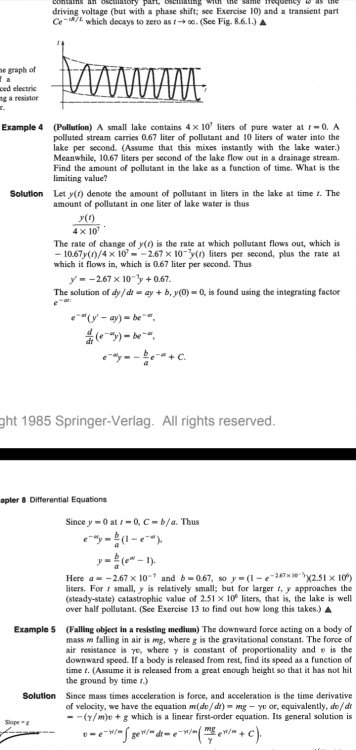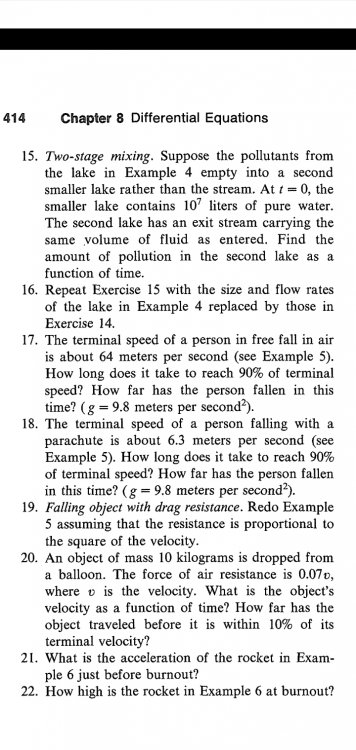Number 15 says
Suppose the pollutants from the lake in example 4 flow into a smaller lake rather than the stream. At t= 0 the smaller lake has volume \(\displaystyle 10^7\) liters. The second lake has an exit stream carrying the same volume of fluid as entered. Find the amount of pollution in the second lake as a function of time.
In example 4 you had a lake that had, initially, \(\displaystyle 4 \times 10^7\) liters of pure water. There was a stream with .67 liters of pollutant and 10 liters of water flow in per minute, and 10+ .67= 10.67 liter of water and pollutant flow out per minute. Since the number of liters of water and pollutant coming in and going out are the same, the amount of liquid in the lake is constant, 10 liters.
Let y(t) be the amount of pollutant, in liters, in the first lake and let z(t) be the amount of pollutant, in liters, in the second lake, at time t minutes since the initial time.
Then dy/dt is the rate at which the amount of pollutant in the first lake changes per minute. It changes in two ways. First there are 0.67 liters of pollutant coming in every minute. The y(t) liters of pollutant mixes with the 10 liters in the lake so there are \(\displaystyle \frac{y(t)}{10}\) liters of pollutant per liter of lake. That means that the 10.67 liters of fluid going out contains \(\displaystyle \frac{10.67y(t)}{4 \times 10^7}\) liters of pollutant per minute.
The equation for the amount of pollutant in the first lake is \(\displaystyle \frac{dy}{dt}= 0.67- \frac{10.67y}{4\times 10^7}\).
The equation for the second lake is similar except that the amount of pollutant coming in is not constant but is the amount coming out of the first lake, \(\displaystyle \frac{10.67y}{4\times 10^7}\(\displaystyle . The amount going out is the concentration per liter, \(\displaystyle \frac{z}{10^7}\) times the rate at which the fluid is going out, the same as for the first lake, 10.67 liters per minute so the pollutant is going out at \(\displaystyle \frac{10.67z}{10^7}\) liters per minute.
The differential equation for the second lake is
\(\displaystyle \frac{dz}{dt}= \frac{10.67y}{4\times 10^7}- \frac{z}{10^7}\).
Solve those two equations for y and z with initial values y(t)= 0 and z(t)= 0 since neither lake had any pollutant to begin with.
The first equation does not involve "z" so solve it first, then replace y in the second equation by that function.\)\)




